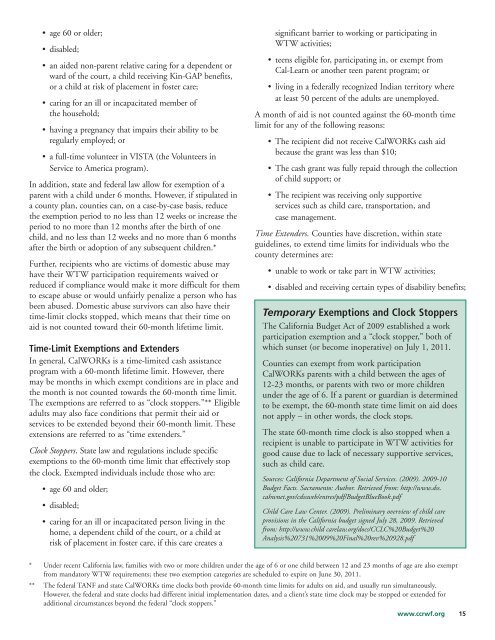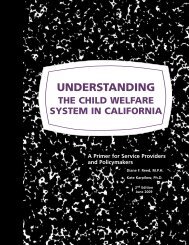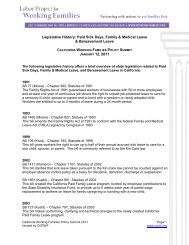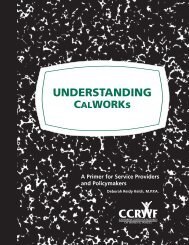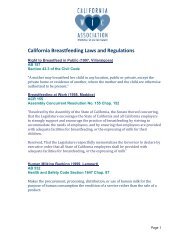Understanding CalWORKs - California Center for Research on ...
Understanding CalWORKs - California Center for Research on ...
Understanding CalWORKs - California Center for Research on ...
You also want an ePaper? Increase the reach of your titles
YUMPU automatically turns print PDFs into web optimized ePapers that Google loves.
• age 60 or older;• disabled;• an aided n<strong>on</strong>-parent relative caring <str<strong>on</strong>g>for</str<strong>on</strong>g> a dependent orward of the court, a child receiving Kin-GAP benefits,or a child at risk of placement in foster care;• caring <str<strong>on</strong>g>for</str<strong>on</strong>g> an ill or incapacitated member ofthe household;• having a pregnancy that impairs their ability to beregularly employed; or• a full-time volunteer in VISTA (the Volunteers inService to America program).In additi<strong>on</strong>, state and federal law allow <str<strong>on</strong>g>for</str<strong>on</strong>g> exempti<strong>on</strong> of aparent with a child under 6 m<strong>on</strong>ths. However, if stipulated ina county plan, counties can, <strong>on</strong> a case-by-case basis, reducethe exempti<strong>on</strong> period to no less than 12 weeks or increase theperiod to no more than 12 m<strong>on</strong>ths after the birth of <strong>on</strong>echild, and no less than 12 weeks and no more than 6 m<strong>on</strong>thsafter the birth or adopti<strong>on</strong> of any subsequent children.*Further, recipients who are victims of domestic abuse mayhave their WTW participati<strong>on</strong> requirements waived orreduced if compliance would make it more difficult <str<strong>on</strong>g>for</str<strong>on</strong>g> themto escape abuse or would unfairly penalize a pers<strong>on</strong> who hasbeen abused. Domestic abuse survivors can also have theirtime-limit clocks stopped, which means that their time <strong>on</strong>aid is not counted toward their 60-m<strong>on</strong>th lifetime limit.Time-Limit Exempti<strong>on</strong>s and ExtendersIn general, <str<strong>on</strong>g>CalWORKs</str<strong>on</strong>g> is a time-limited cash assistanceprogram with a 60-m<strong>on</strong>th lifetime limit. However, theremay be m<strong>on</strong>ths in which exempt c<strong>on</strong>diti<strong>on</strong>s are in place andthe m<strong>on</strong>th is not counted towards the 60-m<strong>on</strong>th time limit.The exempti<strong>on</strong>s are referred to as “clock stoppers.”** Eligibleadults may also face c<strong>on</strong>diti<strong>on</strong>s that permit their aid orservices to be extended bey<strong>on</strong>d their 60-m<strong>on</strong>th limit. Theseextensi<strong>on</strong>s are referred to as “time extenders.”Clock Stoppers. State law and regulati<strong>on</strong>s include specificexempti<strong>on</strong>s to the 60-m<strong>on</strong>th time limit that effectively stopthe clock. Exempted individuals include those who are:• age 60 and older;• disabled;• caring <str<strong>on</strong>g>for</str<strong>on</strong>g> an ill or incapacitated pers<strong>on</strong> living in thehome, a dependent child of the court, or a child atrisk of placement in foster care, if this care creates asignificant barrier to working or participating inWTW activities;• teens eligible <str<strong>on</strong>g>for</str<strong>on</strong>g>, participating in, or exempt fromCal-Learn or another teen parent program; or• living in a federally recognized Indian territory whereat least 50 percent of the adults are unemployed.A m<strong>on</strong>th of aid is not counted against the 60-m<strong>on</strong>th timelimit <str<strong>on</strong>g>for</str<strong>on</strong>g> any of the following reas<strong>on</strong>s:• The recipient did not receive <str<strong>on</strong>g>CalWORKs</str<strong>on</strong>g> cash aidbecause the grant was less than $10;• The cash grant was fully repaid through the collecti<strong>on</strong>of child support; or• The recipient was receiving <strong>on</strong>ly supportiveservices such as child care, transportati<strong>on</strong>, andcase management.Time Extenders. Counties have discreti<strong>on</strong>, within stateguidelines, to extend time limits <str<strong>on</strong>g>for</str<strong>on</strong>g> individuals who thecounty determines are:• unable to work or take part in WTW activities;• disabled and receiving certain types of disability benefits;Temporary Exempti<strong>on</strong>s and Clock StoppersThe <str<strong>on</strong>g>Cali<str<strong>on</strong>g>for</str<strong>on</strong>g>nia</str<strong>on</strong>g> Budget Act of 2009 established a workparticipati<strong>on</strong> exempti<strong>on</strong> and a “clock stopper,” both ofwhich sunset (or become inoperative) <strong>on</strong> July 1, 2011.Counties can exempt from work participati<strong>on</strong><str<strong>on</strong>g>CalWORKs</str<strong>on</strong>g> parents with a child between the ages of12-23 m<strong>on</strong>ths, or parents with two or more childrenunder the age of 6. If a parent or guardian is determinedto be exempt, the 60-m<strong>on</strong>th state time limit <strong>on</strong> aid doesnot apply – in other words, the clock stops.The state 60-m<strong>on</strong>th time clock is also stopped when arecipient is unable to participate in WTW activities <str<strong>on</strong>g>for</str<strong>on</strong>g>good cause due to lack of necessary supportive services,such as child care.Sources: <str<strong>on</strong>g>Cali<str<strong>on</strong>g>for</str<strong>on</strong>g>nia</str<strong>on</strong>g> Department of Social Services. (2009). 2009-10Budget Facts. Sacramento: Author. Retrieved from: http://www.dss.cahwnet.gov/cdssweb/entres/pdf/BudgetBlueBook.pdfChild Care Law <str<strong>on</strong>g>Center</str<strong>on</strong>g>. (2009). Preliminary overview of child careprovisi<strong>on</strong>s in the <str<strong>on</strong>g>Cali<str<strong>on</strong>g>for</str<strong>on</strong>g>nia</str<strong>on</strong>g> budget signed July 28, 2009. Retrievedfrom: http://www.child carelaw.org/docs/CCLC%20Budget%20Analysis%20731%2009%20Final%20rev%20928.pdf* Under recent <str<strong>on</strong>g>Cali<str<strong>on</strong>g>for</str<strong>on</strong>g>nia</str<strong>on</strong>g> law, families with two or more children under the age of 6 or <strong>on</strong>e child between 12 and 23 m<strong>on</strong>ths of age are also exemptfrom mandatory WTW requirements; these two exempti<strong>on</strong> categories are scheduled to expire <strong>on</strong> June 30, 2011.** The federal TANF and state <str<strong>on</strong>g>CalWORKs</str<strong>on</strong>g> time clocks both provide 60-m<strong>on</strong>th time limits <str<strong>on</strong>g>for</str<strong>on</strong>g> adults <strong>on</strong> aid, and usually run simultaneously.However, the federal and state clocks had different initial implementati<strong>on</strong> dates, and a client’s state time clock may be stopped or extended <str<strong>on</strong>g>for</str<strong>on</strong>g>additi<strong>on</strong>al circumstances bey<strong>on</strong>d the federal “clock stoppers.”www.ccrwf.org15


